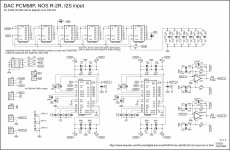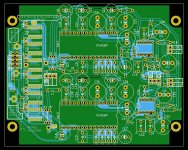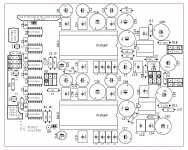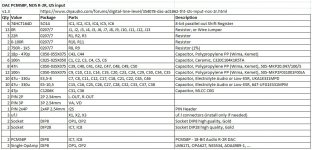LE has only one function whereas LRCLK and WS also delineate left from right. They are not the same because they are not interchangeable. To suggest otherwise is unwise.Yes but I just want to point that the main function is the same. to tell DAC to convet datas.
Canford Audio was selling a dac for digital audio test purposes that had no filter long before Nov 1996 and a lot of the CX20017 and CX20152 based players also had no digital filter and they also predate Mr Kusunoki. The filter free Sony CDP-101 goes back to around 1985.View attachment 1076606
Non-oversampling Digital filter-less DAC Concept by Ryohei Kusunoki Nov. 1996
https://archive.is/92aQ5
He was the first to insert shifters into the DAC without filter. And it stands everywhere as a reference.Mr Kusunoki.
Juaneda site...etc...
Setting aside that you don't need shifters for the TDA1543, far be it for me to poo-poo your beliefs but if you don't mind I'll stick with the hard evidence.He was the first to insert shifters into the DAC without filter. And it stands everywhere as a reference.
For obsessive perfectionists worried about the delay between channels you can try and see if its discernable by using DSP channel delay as a test model.The delay becomes progressively shorter as the sample rate increases. Formula is: 1/Fs (Fs being the sample rate), divided by 2.
192kHz > 2.6uS (millionths of a second) = less than 1mm of offset
384kHz > 1.3uS (millionths of a second) = less than 0.5mm of offset
Go for the worst case scenario. That would appear to be NOS 44.1kHz files with a stereo that does razor imaging eg ESL's. With the delay of 44.1 / 2 = 11.3uS or 3.889mm ~ 4mm.
A small time shift will mainly move imaging and research suggests "Localization accuracy is 1 degree for sources in front of the listener .... can discern interaural time differences of 10uS". The 10uS is very close to the worst case scenario of 11.3uS and a one degree shift would seems hard to pick.
DSP are free in Foobar:
For a pure tone test in Foobar: playlist-> add location tone://Hz,Seconds and use DSP mono to stereo
For DBT Foobar allows test files to be saved with DSP and tested with ABX.
Lastly DSP can also be used to correct for any time delay. If anyone is still bothered with the idea of the channel time delay on these DACs just use the DSP to correct the channel delay. As long as you know which channel to delay 🙂
Rather than preach to those who will not be converted would it not be better to just let obsessive perfectionists be obsessive perfectionists.For obsessive perfectionists....
I realized a few pages earlier that no one can hear that delay, and I'm not a bat that my ears serve as an echo location. 🦇
shifters + R10 and R11hello mikorist, what is the resistors brand "r8, r9, r10, r11" you are using on pcm63?
https://www.mouser.de/ProductDetail/Vishay-Dale/RN55C22R1BB14?qs=hyU79xNWhW3UkUldLLl8AA==
R8 and R9
https://www.mouser.de/ProductDetail/Vishay-Dale/RN60C1261BRE6?qs=eCRHGxC%2Bb3UVd/TECC84eA==
Hello
May I ask anyone who stay in hk want to buy ad1862 for spare parts or actually need
I am gathering people and going to buy at Rochester electronics
May you please PM me if interested
May I ask anyone who stay in hk want to buy ad1862 for spare parts or actually need
I am gathering people and going to buy at Rochester electronics
May you please PM me if interested
Maybe some were born on the planet Krypton 🤣I realized a few pages earlier that no one can hear that delay, and I'm not a bat that my ears serve as an echo location. 🦇
got it, thank you.
If you don't already have an account with Rochester, consider Digi-Key. Rochester sells through them and it's immensely easier to buy than to set up an account @ Rochester.Hello
May I ask anyone who stay in hk want to buy ad1862 for spare parts or actually need
I am gathering people and going to buy at Rochester electronics
May you please PM me if interested
Bat-hearing is not needed to hear the effects of inter-channel delay. It distroys the coherence of the central sound stage image. Why? The central image is the sum of the left and right channel. Delaying one channel sets up a comb filter that enhances some and diminishes other frequencies to different degrees. If you can't hear that it means your audio system is not coherent to begin with.I realized a few pages earlier that no one can hear that delay, and I'm not a bat that my ears serve as an echo location. 🦇
I’m afraid I think I missed the point trying to be made about delayed Bits and Miro’s dac board?
Tam Lin, are you saying that Miro’s implementation of shift registers on these boards is incorrectly done? Therefore, we are hearing interchannel delay with destroyed coherence and central sound stage image?
I’ve built a half dozen of these boards in all different component combinations and I/V output stages. I’ve never once thought the sound stage or imaging suffered in any way. Actually, I think quite the opposite, the sound stage and imaging is superb. Even with basic opamp I/V I’ve heard nothing offensive.
These dac boards are not expensive to build, If you’d like, I can send you a pcb so you can build it and listen. I think you’ll be surprised 🙂
Tam Lin, are you saying that Miro’s implementation of shift registers on these boards is incorrectly done? Therefore, we are hearing interchannel delay with destroyed coherence and central sound stage image?
I’ve built a half dozen of these boards in all different component combinations and I/V output stages. I’ve never once thought the sound stage or imaging suffered in any way. Actually, I think quite the opposite, the sound stage and imaging is superb. Even with basic opamp I/V I’ve heard nothing offensive.
These dac boards are not expensive to build, If you’d like, I can send you a pcb so you can build it and listen. I think you’ll be surprised 🙂
@Vunce In my DACs is no delay between channels because both channels are latched together 😉
"Inaudible" delay is present only if 4 shift registers (32-bit buffer) would be omitted and LRCK inverted for the second channel - and this is not case for my DACs 🤓
Only this stopped-clock version has the delay: #3969 ... but I created also another stopped-clock version with 32-bit buffer where the delay is not present (only PCB with shift registers is somewhere in the forum, I haven't done the whole DAC PCB yet 🤣). But I made the PCB for the PCM58P (seems like PCM63’s father 🤔 ), I'm just preparing the materials for the post LOOL 🤣
"Inaudible" delay is present only if 4 shift registers (32-bit buffer) would be omitted and LRCK inverted for the second channel - and this is not case for my DACs 🤓
Only this stopped-clock version has the delay: #3969 ... but I created also another stopped-clock version with 32-bit buffer where the delay is not present (only PCB with shift registers is somewhere in the forum, I haven't done the whole DAC PCB yet 🤣). But I made the PCB for the PCM58P (seems like PCM63’s father 🤔 ), I'm just preparing the materials for the post LOOL 🤣
Yes, you missed the point and I have no interest in any DAC that uses I2S. I know reading datasheets is frowned upon in this forum, but if you read the I2S datasheet and learn its history you would see how absurd the current diyAudio obsession with it is.I’m afraid I think I missed the point trying to be made about delayed Bits and Miro’s dac board? ... If you’d like, I can send you a pcb so you can build it and listen.
I2S was created to eliminate the need for the sender and receiver to agree ahead of time as to the format of the sample data. The sender sends as many bits as it has and the receiver accepts as many bits as it needs. Requiring a 64-bit frame to send two 16-bit samples and every DAC to have multiple redundant shift registers is beyond stupid. Especially when the DAC circuit designers don't understand how shift registers work and are too stupid to read about the different time-tested methods that have been develop[ed to get around the well-known problems.
There are many more reasons that make I2S the worst choice for reliable data transfer but I won't bore you with the obvious.
PCM58P
DAC is 18-Bit
Very good DAC chip, it is the predecessor of the PCM63P.
The power supply is different from the PCM63!
analog part: +12VA, -12VA
digital part: +5VD
Output capacitor C43 + C44 is optional - try the sound without this capacitor 🤔
BOM example: https://www.mouser.com/ProjectManager/ProjectDetail.aspx?AccessID=e902fc1e77
Note: Very experimental PCB, it may not work at all (sorry for any errors) 🤣
DAC is 18-Bit
Very good DAC chip, it is the predecessor of the PCM63P.
The power supply is different from the PCM63!
analog part: +12VA, -12VA
digital part: +5VD
Output capacitor C43 + C44 is optional - try the sound without this capacitor 🤔
BOM example: https://www.mouser.com/ProjectManager/ProjectDetail.aspx?AccessID=e902fc1e77
Note: Very experimental PCB, it may not work at all (sorry for any errors) 🤣
Attachments
-
diyAudio_PCM58P_DAC_v1.3_uf.l_2022-08-01.zip732 KB · Views: 225
-
 diyAudio_PCM58P_DAC_v1.3_uf.l_Schematic.jpg383.1 KB · Views: 676
diyAudio_PCM58P_DAC_v1.3_uf.l_Schematic.jpg383.1 KB · Views: 676 -
 diyAudio_PCM58P_DAC_v1.3_uf.l_TOP.jpg527 KB · Views: 641
diyAudio_PCM58P_DAC_v1.3_uf.l_TOP.jpg527 KB · Views: 641 -
 diyAudio_PCM58P_DAC_v1.3_uf.l_Parts.jpg273.7 KB · Views: 511
diyAudio_PCM58P_DAC_v1.3_uf.l_Parts.jpg273.7 KB · Views: 511 -
 diyAudio_PCM58P_DAC_v1.3_uf.l_BOM.jpg157.8 KB · Views: 565
diyAudio_PCM58P_DAC_v1.3_uf.l_BOM.jpg157.8 KB · Views: 565
And i can't hear that on Tannoy speakers, which normally require a compass to set the sweet spot.I’ve built a half dozen of these boards in all different component combinations and I/V output stages. I’ve never once thought the sound stage or imaging suffered in any way. Actually, I think quite the opposite, the sound stage and imaging is superb. Even with basic opamp I/V I’ve heard nothing offensive.
So this whole story about not moving the listener's head is nebulous.
Last edited:
- Home
- Source & Line
- Digital Line Level
- DAC AD1862: Almost THT, I2S input, NOS, R-2R